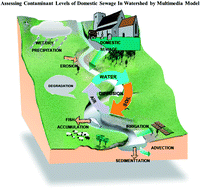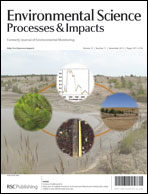Multimedia modeling of the fate of triclosan and triclocarban in the Dongjiang River Basin, South China and comparison with field data†
Abstract
Triclosan (TCS) and triclocarban (TCC) are two active ingredients widely used in many home and personal care products. Multimedia fate of TCS and TCC in the Dongjiang River basin, South China were addressed by the developed level III fugacity model based on their usage. Under the assumption of steady state, the concentrations in air, water, soil, sediment, suspended particulate matter (SPM) and fish as well as transfer flux across the interface between the compartments were simulated. The measured concentrations for the two compounds in water, SPM, and sediment from field monitoring campaigns were then compared to validate the model. The results showed that the model predicted reasonably accurate concentrations and the differences between the measured and modeled concentrations were all less than 0.7 log units. TCS and TCC had a tendency to distribute into the sediment phase, which accounted for more than 66.3% and 90.3% of the total masses, respectively. Wastewater discharge was the main source for the occurrence of the two compounds in the aquatic environment, while degradation was the primary process for the loss in the study area, followed by the advection export. Sensitivity analysis showed that the most influential parameters for the fate of the target chemicals were source term, degradation rates and adsorption coefficients. Monte Carlo simulation could well describe the modeling uncertainty and variability.


 Please wait while we load your content...
Please wait while we load your content...